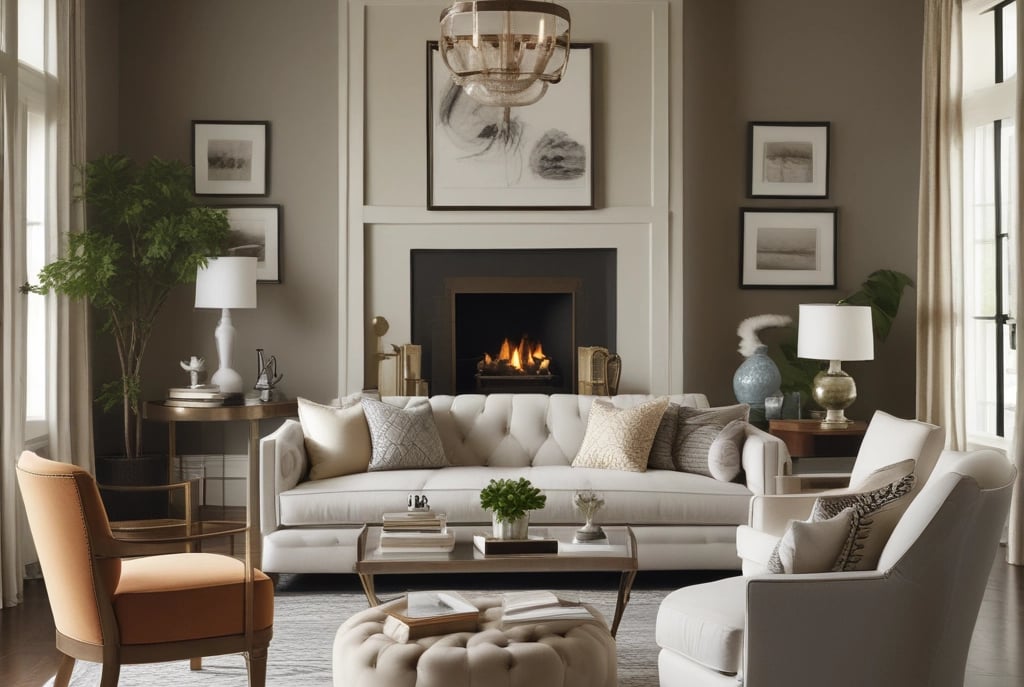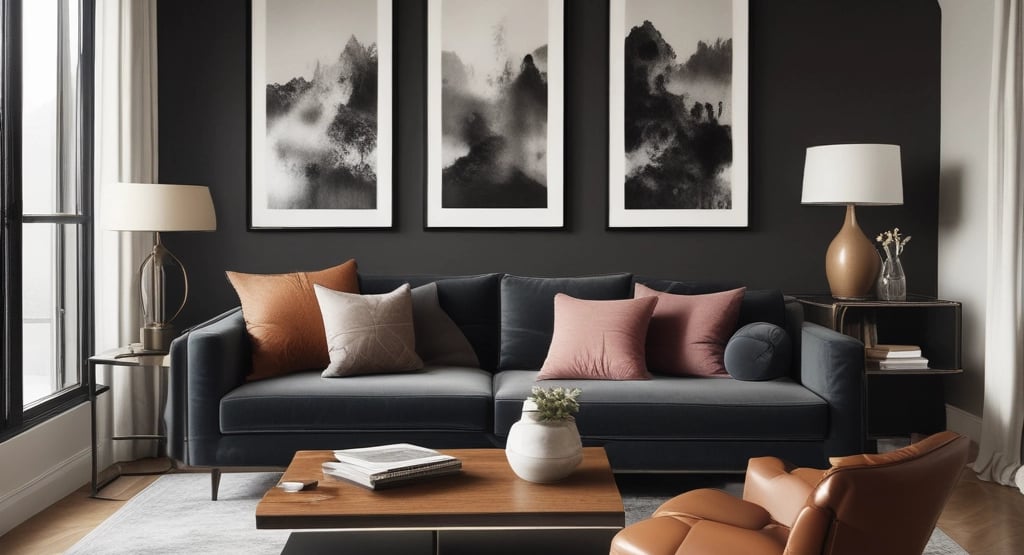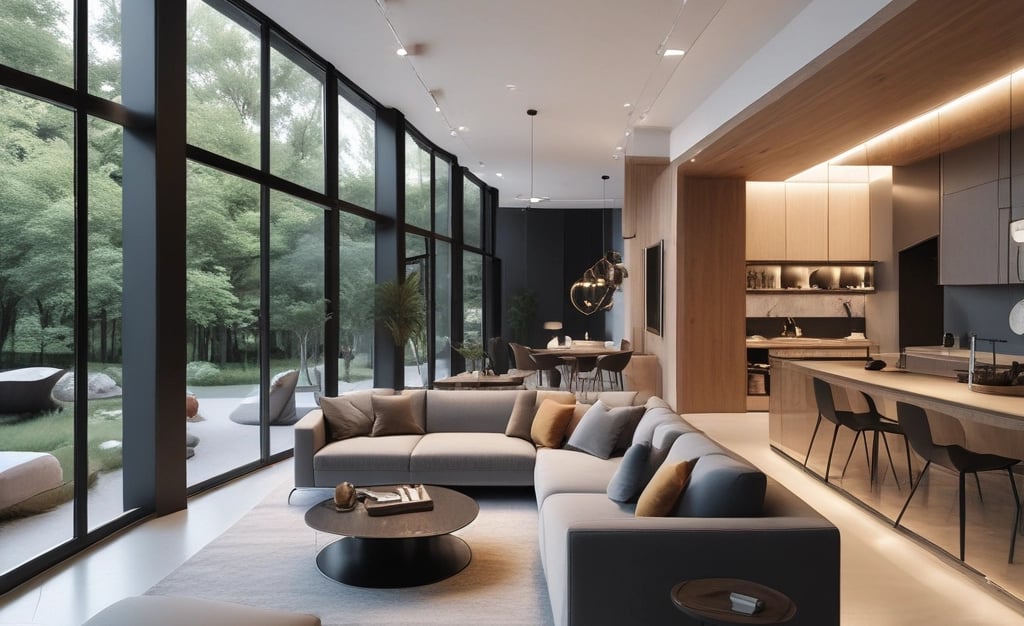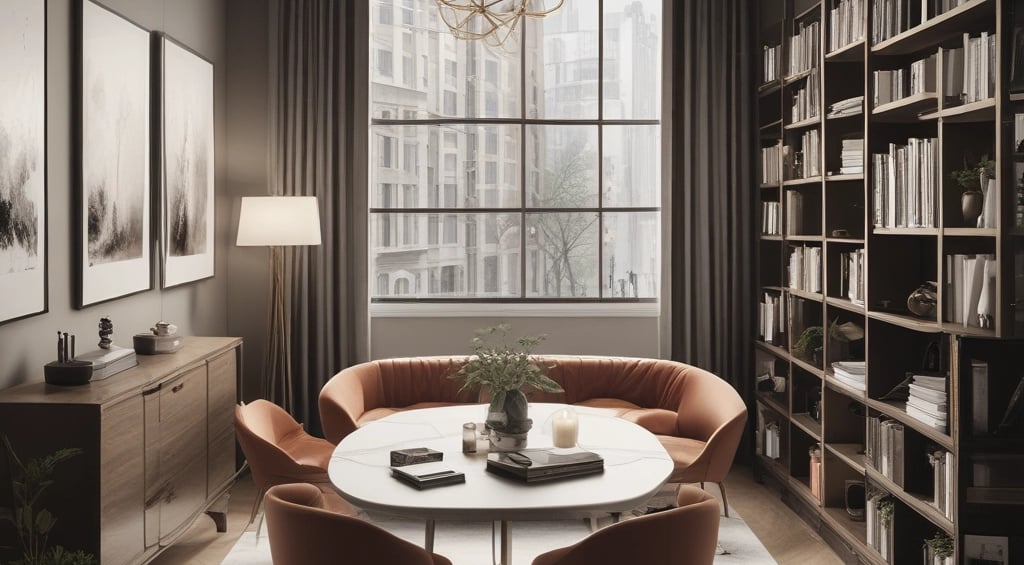Deep Focus into Interior Design: Essential Concepts, Practical Styling, and Advanced Techniques
HOME DESIGN IDEAS
Mohamed Amine
10/23/20259 min read


Understanding the Core Principles of Interior Design
Interior design is fundamentally grounded in a set of core principles that guide the creation of aesthetically pleasing and functional spaces. Understanding these principles balance, harmony, rhythm, contrast, and proportion is essential for both novice and experienced designers, as each plays a critical role in how a space is perceived and utilized.
Balance refers to the visual weight distribution within a room. It can be achieved through symmetrical or asymmetrical arrangements, where symmetry creates stability and order, while asymmetry offers a more dynamic and casual feel. For example, a balanced arrangement of furniture around a central coffee table can anchor the space, promoting a cohesive visual experience.
Harmony, closely related to balance, encompasses the cohesive quality of a design. It involves the thoughtful combination of colors, textures, and materials that create a unified look. Designers often achieve harmony through a consistent color palette or the use of recurring design motifs that resonate throughout the space. For instance, using similar shades of blue in both upholstery and wall color can evoke a calming atmosphere that ties the room together.
Rhythm in interior design refers to the repetition of elements to guide the eye smoothly through a space. This can be accomplished through patterns, colors, or textures. For example, repeating a certain shape in the cushions and lighting fixtures can create a visual rhythm that enhances the overall flow of the design.
Contrast serves to emphasize key elements within a space, drawing attention to particular features or areas. This could involve the juxtaposition of light and dark colors, as well as the mixing of modern and traditional styles. Finally, proportion is about the relationship between the sizes of different elements within a space. Correct proportion ensures that furnishings work harmoniously together, ultimately creating an inviting and well-designed environment.
In summary, these core principles of interior design are instrumental in crafting spaces that are not only visually appealing but also functionally effective. By mastering these concepts, designers can create environments that resonate with both their aesthetic intentions and the practical needs of the occupants.
The Psychology of Space and Human Perception
Interior design is not merely an aesthetic pursuit; it is deeply intertwined with human psychology. The elements of design color, lighting, and texture play a crucial role in shaping emotions and behaviors within a space. Color theory, for instance, hinges on the psychological effects that different hues exert on individuals. Warm colors such as red and orange can evoke excitement and energy, while cool colors like blue and green tend to create a sense of calm and tranquility. Understanding these nuances enables designers to craft environments that resonate with the intended mood and function of the space.
Lighting choices add another layer of complexity to the psychological impact of interior design. Natural light, widely praised for its mood-enhancing qualities, should be maximized wherever possible, as it can help elevate spirits and improve productivity. Conversely, dim or harsh artificial lighting may lead to feelings of fatigue or discomfort. By harnessing the principles of layered lighting ncorporating ambient, task, and accent lighting designers can create dynamic spaces that support various activities while promoting well-being.
Texture variations also contribute significantly to the psychological experience of a space. Soft textures, such as plush fabrics and rounded furniture, invite comfort, while sleek, hard surfaces may evoke a sense of cleanliness and sophistication. By thoughtfully integrating textures, interior designers can create spaces that appeal to the tactile senses, enhancing overall satisfaction.
Finally, spatial arrangements are pivotal in influencing occupant behavior and comfort. An effective layout promotes ease of movement and encourages social interaction, while overcrowded or awkward setups can hinder functionality. Designers must consider flow and accessibility when planning interiors, as these factors can profoundly affect the occupants' experience and well-being. Understanding the psychology of space equips designers with the tools needed to create environments that not only look good but also feel good.
Innovative Styling Techniques for Modern Interiors
As interior design continues to evolve, innovative styling techniques play a crucial role in enhancing the aesthetics of modern interiors. One effective method to elevate design is through layering textures. Combining various materials such as wood, metal, and textiles can add depth and interest to a space. For instance, pairing a sleek leather sofa with plush velvet cushions not only provides physical comfort but also invites visual engagement, creating a well-rounded contemporary atmosphere.
Utilizing statement pieces is another fundamental technique that can redefine a room. An oversized artwork or a unique sculpture can serve as a central element that draws the eye and sparks conversation. When selecting a statement piece, consider items that resonate with personal taste and bring a sense of personality to the environment. This not only enhances the room’s character but also complements the overall design narrative.
Incorporating personal elements, such as photographs or heirlooms, into modern designs helps to develop a unique style that represents the inhabitants' identities. These items can serve as poignant reminders of experiences and relationships, allowing the artworks to create emotional connections within the space. Integrating personal flair not only enhances visual interest but also creates warmth, making it a welcoming environment for both residents and guests.
Creating focal points is essential when styling modern interiors. This can be achieved by using contrasting colors, distinctive furniture arrangements, or lighting elements that bring attention to desired areas. Moreover, blending different design styles such as contemporary with mid-century elements can create a dynamic and layered appeal. This technique promotes creativity and uniqueness, encouraging the exploration of various aesthetic influences and allowing homeowners to express their individuality.
Sustainability and Eco-friendly Practices in Interior Design
The concept of sustainability has gained significant traction in interior design, as designers increasingly recognize the need to create spaces that are both aesthetically pleasing and environmentally responsible. This trend is fueled by a growing awareness of climate change and the impact that conventional design practices have on our planet. To that end, implementing eco-friendly materials is a fundamental aspect of sustainable interior design. Such materials include bamboo, reclaimed wood, and recycled metal, which not only reduce the carbon footprint of a project but also add unique character and charm to various spaces.
Sustainable sourcing is another crucial factor in eco-friendly design. It involves selecting materials and products from suppliers who adhere to environmentally conscious practices. These practices can range from using renewable resources to ensuring fair labor conditions. By supporting companies that prioritize sustainability, designers contribute to a positive cycle that encourages the industry to embrace eco-friendliness. Furthermore, incorporating energy-efficient solutions into interior spaces, such as LED lighting, Energy Star-rated appliances, and smart home technologies, leads to reduced energy consumption and long-term cost savings.
Real-world case studies illustrate the successful application of these concepts. For instance, a recent project in a commercial office space demonstrated the transformation of a previously dated environment into a vibrant, eco-conscious setting. By utilizing upcycled furnishings, implementing a green roof, and investing in natural lighting, the design not only enhanced employee well-being but also achieved significant energy savings. Such cases reinforce the idea that sustainable interior design is not merely a trend; it represents a thoughtful approach that harmonizes environmental responsibility with practical and appealing design strategies.
Advanced Techniques in Space Planning
Effective space planning is a critical component of interior design, allowing for the harmonious arrangement of elements within a defined area. One of the primary techniques used in this discipline is the concept of flow, which ensures that movement within a space is intuitive and unhindered. Analyzing traffic patterns, such as entry and exit points, can significantly enhance the user experience, making a space feel larger and more functional. By prioritizing pathways while placing furniture and fixtures, designers can create an inviting atmosphere that facilitates interaction and movement.
Zoning is another essential technique that contributes to optimal space planning. This method involves dividing a larger area into smaller zones, each designated for specific purposes, such as living, working, or relaxing. Proper zoning allows for the effective use of available space while maintaining a sense of order and organization. Utilizing visual separations, such as rugs, furniture placement, or decorative screens, can help delineate these areas without the need for permanent structural changes, making it particularly advantageous in open floor plans.
Functional space allocation tailored to individual needs is crucial in maximizing interior spaces. This involves identifying the requirements of the users and allocating space accordingly. For instance, creating multipurpose areas can significantly enhance the overall utility of a room, especially in smaller homes where every square foot matters. Incorporating multifunctional furniture, such as foldable tables or expandable seating, can transform a limited area into a versatile environment capable of accommodating various activities.
In addition, strategic storage solutions play a key role in advanced space planning. Optimizing vertical space, using built-in cabinetry, and employing hidden storage options can minimize clutter while maintaining accessibility. By prioritizing efficient designs that cater to specific requirements, interior designers can ensure that each space not only looks aesthetically pleasing but also functions effectively for its intended use.
Trends and Innovations in Interior Design
The interior design industry is constantly evolving, influenced by a multitude of factors ranging from technological advancements to shifting consumer preferences. One prominent trend in recent years is the growing emphasis on sustainability. Designers are increasingly incorporating eco-friendly materials and energy-efficient appliances into their projects, reflecting a broader societal shift toward environmental consciousness. This commitment to sustainable design not only appeals to consumers but also aligns with global initiatives aimed at reducing carbon footprints.
Emerging styles such as biophilic design, which integrates natural elements into indoor spaces, are gaining traction as well. This approach emphasizes the connection between nature and interior environments, promoting well-being and reducing stress among inhabitants. By utilizing living greenery, natural light, and organic materials, biophilic design fosters a refreshing atmosphere that enhances the overall experience of a space.
Moreover, the integration of technology in interior design is becoming increasingly sophisticated. Smart home systems are now commonplace, enabling homeowners to control lighting, temperature, and security through user-friendly interfaces. Designers are exploring ways to seamlessly blend technology into living spaces without compromising aesthetic appeal. For instance, hidden outlets, smart lighting options, and integrated sound systems provide a modern touch while ensuring a clean and uncluttered appearance.
Social media platforms play a significant role in shaping contemporary design preferences. Instagram, Pinterest, and TikTok have become valuable resources for inspiration, where trends can rapidly gain popularity. Designers are not only utilizing these platforms for inspiration but are also engaging with audiences directly, allowing for a collaborative dialogue that influences design choices. Insights from industry leaders suggest that leveraging social media trends is essential for staying relevant in an ever-changing market.
In conclusion, the interior design landscape is marked by a myriad of innovations and trends that reflect societal values, technological advancements, and changing aesthetics. By understanding these elements, designers can better position themselves to meet the evolving demands of their clients.
Creating a Personal Design Philosophy
Developing a personal design philosophy is a vital step in the journey of interior design. At its core, your design philosophy should reflect your unique identity, preferences, and values. By understanding and articulating your individual style, you can create spaces that not only look appealing but also resonate with your personal experiences and aspirations. The first step in establishing your design philosophy is self-reflection. Consider what makes you feel comfortable and inspired within a space. Think about colors, patterns, materials, and styles that evoke positive emotions.
Another critical aspect to consider is your values. The choices you make in design can be influenced by environmental concerns, cultural significance, and personal beliefs. Are you drawn to sustainable materials, locally sourced furnishings, or perhaps historical designs? Understanding these values will guide you in making design decisions that are not only aesthetically pleasing but also meaningful to you. Furthermore, your lived experiences play a significant role in shaping your design choices. Reflect on the places that have made a strong impression on you, be it your childhood home, a memorable vacation spot, or even art that has moved you. These influences can inspire elements in your own design philosophy.
Once you have a clearer understanding of your preferences, values, and inspirations, it is helpful to gather visual references that align with your vision. Create a mood board or digital collage featuring images, colors, and textures that resonate with you. This tangible representation of your ideas serves not only as a source of inspiration but also as a guiding framework for future design decisions. By integrating your individuality into your spaces, you can ensure that the resulting designs are authentic, coherent reflections of who you are.
Conclusion
Delving deep into interior design reveals that the art and science of shaping spaces go far beyond visual appeal - it is about creating environments that enrich daily living, reflect personality, and balance emotion with function. From the foundational principles of proportion and balance to the psychology of space, each element contributes to how people feel and interact within their surroundings. The thoughtful use of color, texture, and light transforms ordinary rooms into meaningful experiences that communicate identity and purpose.
In today’s evolving world, technology and sustainability have become integral to modern design thinking. Designers who go deep into interior design must integrate digital visualization tools, eco-conscious materials, and smart systems to deliver spaces that are both innovative and responsible. The blending of creativity with functionality ensures that every interior tells a story while serving practical needs.
Ultimately, interior design is not a static discipline but a dynamic field that adapts to cultural shifts, technological advancements, and environmental awareness. By mastering essential concepts, applying practical styling, and embracing advanced techniques, designers can shape spaces that are timeless, inspiring, and sustainable. This deep focus invites both professionals and enthusiasts to see design not merely as decoration, but as a transformative process that harmonizes aesthetics, well-being, and purpose within every built environment.
References
Interior Design Course: Principles, Practices, and Techniques
Author: by Tomris Tangaz
Link: Interior Design CourseThe Essentials: The Art of Interior Design: A Guide to Incorporating Beauty and Functionality Into Your Home (Interior Design Essentials)
Author: by Dawn DeVries Sokol
Link: The Essentials: The Art of Interior DesignInterior Design Essentials: Interior Design Practice
Author: by Anna Hung & Yana Gorpinich
Link: Interior Design Essentials66 Styles for Interior Design Reference Book (Volumes 1-4)
Author: by Various
Link: 66 Styles for Interior Design Reference Book






